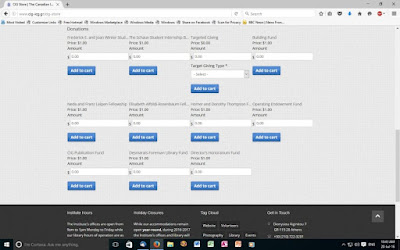It is hard to believe that the summer is half over! Just six weeks ago we celebrated our 40th anniversary with a very successful Colloquium. Our four fieldwork projects and one study season endeavor have all wrapped up their research (their guest blogs will be uploaded in August). Our two interns for the spring/summer have completed their work on the Archives and the Library (their guest blogs will also be uploaded in August). With the end of July comes our annual summer recess for the month of August. As of 13:00 today Friday, the 29th, the Institute will be closed until Thursday, September 1st at 09:00. Jonathan and Amelie will be vacationing in the UK and the southern Peloponessos. We will be in eastern Crete digging (see below) and recovering from the long demanding field season.
CIG Website improvements
One area that our CIG website [www.cig-icg.gr] was deficient in was a feature to allow people to pay for individual memberships (new and renewal) and to make charitable donations online. Now one can do both through our updated website. In addition, members can request and pay for a Museum and Site Entrance Pass through one’s membership account. The Institute’s monographs are available for purchase as well.
The Institute seeks, indeed welcomes, charitable donations to support various aspects of our work. Under the heading “Giving” on the Homepage there is a list of the areas where contributions will make the Institute both stronger and more productive. A new general category is “Targeted Giving”. Here for the “Archive”, “Accommodations” and “Improvements” are lists with specific urgent needs where a donation of say $100-150 can assist us in taking immediate action to resolve the issue. The new online payment system allows individuals to make such a donation securely online. For those seeking an official charitable donation receipt the CIG Treasurer, Jeff Banks, will send it without delay.More Cretan Adventures
For the past month I have been in Siteia in eastern Crete excavating at Dr. Metaxia Tsipopoulou’s ongoing project uncovering the Pre- and Proto-Palatial House Tomb Cemetery at Petras on a hill overlooking the eastern side of the narrow coastal plain where the city is located. Tsipopoulou (Director Emerita, Hellenic Ministry of Culture) has been digging at the Minoan palace, settlement and cemetery for 32 years. I am getting hot and dirty here for the third summer in a row excavating trenches. This year’s six-week field season has archaeologists hailing from Greece, Canada, Spain and the United States. International, eh! Further, a local documentary film producer is documenting our work at the cemetery for a “film” he is creating. We’ll be almost famous!
Broadly speaking the primary objects of this year’s investigations were to determine the northern extent of the house tombs, to complete the excavation of various tombs discovered in previous field seasons and to date more securely the EM IIA burial structures. A secondary goal was to learn more about the re-use of the general area of the cemetery in the 13th and 12th centuries BC as a settlement and as an area possibly for ancestor worship. This year the digging has produced more walls – some suspected and others unexpected – that both clarify the plans of a number of the house tombs as well as indicating that some were larger than previously thought. Another characteristic of this year is the encountering of secondary burials in new areas, as well as two more primary burials. Now at the two-thirds point, the northern limit of the cemetery is clearly defined, most of the house tombs are scheduled to be fully excavated in the next two weeks and there is good evidence for assigning burials to the EM IIA period.The later occupation of the plateau where the cemetery is located has increased attention now as it appears as if considerable effort and resources were given to the structures and walls erected mostly around the edges of the earlier cemetery. They appear to be related to attempts to use the burial place of their “ancestors” to support their claim to the hinterland of the ancient settlement in a period of uncertainty. These stimulating topics have been the focus of most of my digging efforts this year as well as last year.
If you have an Instagram account you can follow my postings of the work and people of the Petras excavation by going to: #petras2016 under the “grubbyminoan” account. On most weekdays I upload 1-5 images of activities that have caught my attention, if not amusement. I have around 50 posts so far that will give you the true flavor of the dig and the diverse personalities involved. I look forward to seeing you follow this string of images.
Well, we look forward to seeing you again at the Institute this coming fall after a restful and enjoyable summer. Jonathan and I are organizing the fall Institute lecture program and the events for our Athens Friends’ Association. Both will be interesting and diverse as always!
Kalo Kalokairi!!!
David Rupp
Director













